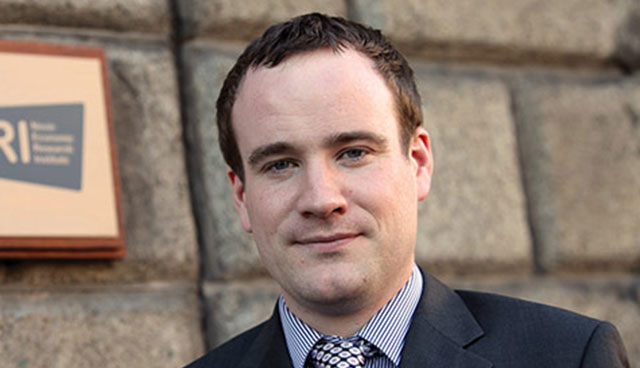Budget: future of public services looks ‘bleak’


Senior economist at the Nevin Economic Research Institute NI (NERI), Paul Mac Flynn, analyses the figures of the recent Northern Ireland and UK budgets, highlighting that despite some positive noises, public spending continues to decrease.
In Northern Ireland, it seems budgets are like buses, you wait all year for one and then two come along at once. The month of November 2017 brought two public spending events for Northern Ireland barely a week and a half apart. The 2017/18 budget for Northern Ireland was delivered by Secretary of State James Brokenshire on the 13 November 2017 while Chancellor of the Exchequer Philip Hammond delivered the 2018/19 UK budget on the 22 November 2017.
What both of these budgets seemed to have in common was a lack of excitement. The Northern Ireland budget was merely an administrative necessity to allow public spending to continue until the end of the financial year, in the absence of a functioning Northern Ireland Executive. It was billed very much as a ‘steady as she goes’ exercise. Likewise, apart from an announcement on stamp duty, the UK budget was considered so dull as to be soporific. However, both budgets contained omens concerning the future of public spending in Northern Ireland and they weren’t good.
Beginning with the Northern Ireland budget, there was much confusion surrounding the announced figures for departmental spending. Unlike most other budgets, much of the money being allocated to departments in this budget had already been spent. The budget produced breakdowns of spending for each department and some surprising issues emerged.
Firstly, the figures presented for 2017/18 were based on mid-year estimates, which means that some of the routine re-allocations from other departments and additional central funding allocations had already happened. These were then compared with 2016/17 figures which were an ‘opening position’ estimates, therefore any direct comparison would have been inaccurate. The experience of the Education Department highlights why this is important. When James Brokenshire published his indicative budget back in the summer, it looked as though education was in line for a rather large cut. Suddenly by November that seemed to have disappeared. In reality, the budget for the Department of Education was indeed cut by 1 per cent in 2017/18. The extra money contained in the 2017/18 reflects one-off adjustments to spending that occur throughout the year. Such adjustments were not included for the 2016/17 figure, making it look as though the education budget had increased. It hadn’t.
Secondly, the departmental totals presented in the 2017/18 budget also augmented the 2016/17 departmental figures by stripping out the allocations for the Voluntary Exit Scheme (VES). This may seem like an incredibly pedantic point, but it had quite an effect on the change in departmental spending for last year. Once again, the experience of the Department of Education is a very good example of this. The VES allocation was included in the current spending allocation for education published in the 2016/17 Northern Ireland Budget. In the 2016/17 budget, current spending of education was given as £1,947.5 million, up ever so slightly from £1,947.3 million in 2015/16.
However, in the 2017/18 budget the current spending allocation for education in 2016/17 is listed as £1,876 million, rising to £1,904 million. The VES funding allocation inflated the 2016/17 figure in last year’s budget which made it look as though there was no reduction in spending. Removing the VES funding from 2016/17 in this year’s budget then made it look as though there was a large increase. You can’t have it both ways.
Looking toward the UK Budget 2018/19, on first glance it looked as though Northern Ireland had done pretty well. The announcement that Northern Ireland would get an additional £650 million over the next three years was widely applauded and it was even claimed that the “Northern Ireland Executive’s block grant will increase in real terms over the Spending Review Period between 2015 and 2020”. The reality is quite different.
Of the £650 million allotted, only £120 million is allocated toward day to day expenditure meaning that, in real terms, spending on public services will fall every year from now until 2020.
The rest of the money was allocated as capital expenditure. You would be forgiven for thinking that this would allow Northern Ireland to go on a spending spree upgrading our infrastructure and building schools and hospitals. Once again, the reality is quite different. Just over 70 per cent of the £540 million capital expenditure is allocated as Financial Transactions Capital. This is money that the Executive can give out in loans to the private sector to build infrastructure. There are two problems with this.
Firstly, it’s not capital expenditure in the classical sense by any stretch of the imagination and it should stop being accounted for as so. Secondly, departments across Northern Ireland have struggled to find projects that they can actually lend this money to. If this money cannot be spent by departments, much of it goes to Invest NI and there is even less information available to us as to what happens to it there.
In summary, the two budgets we had this November tell us two things. The cuts to spending on vital public services such as education are real and ongoing. Secondly, the outlook for the next three years is as bleak as it was before. No amount of creative accounting can hide these facts.







